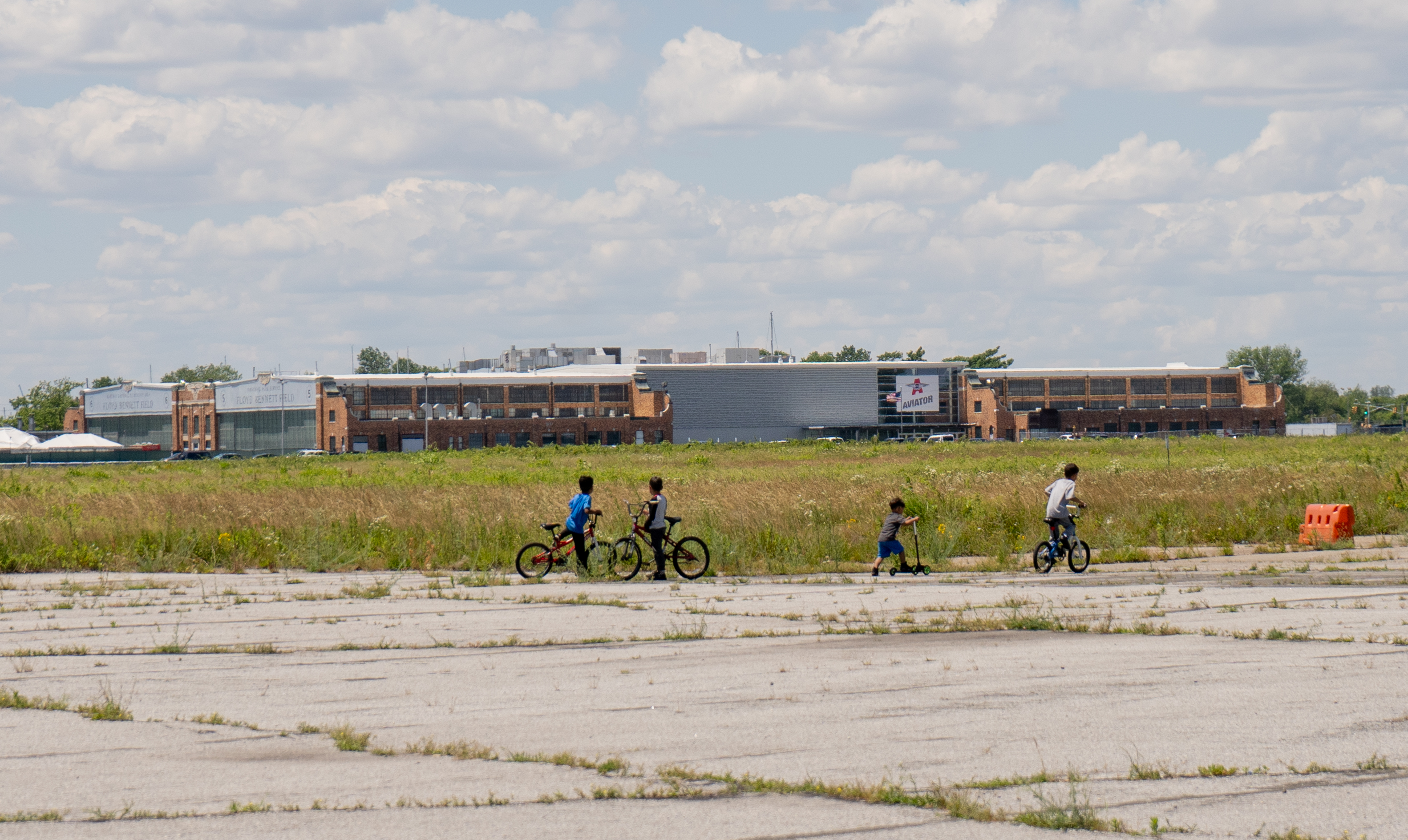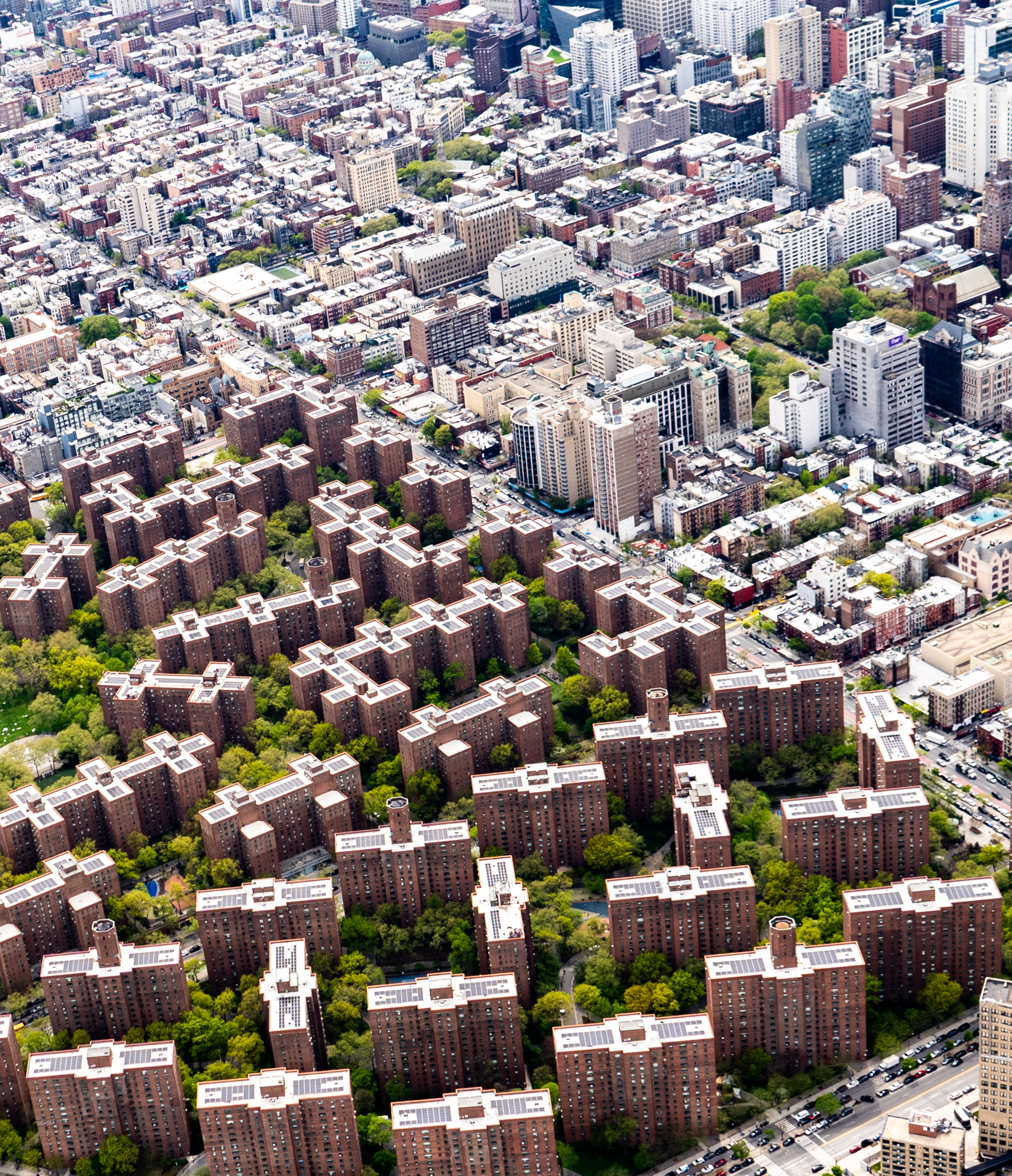How New York City Can Protect Youth and Asylum Seekers at Risk of Homelessness
The Supreme Court decision in Grants Pass v. Johnson will disproportionately impact youth and asylum seekers experiencing homelessness. New York City must opt out of criminalization and focus on proactive housing solutions if it wants to support these especially vulnerable populations.
On the day of the Supreme Court’s oral arguments for City of Grants Pass v. Johnson, people lined up outside the courthouse with sleeping bags and blankets. A mother and daughter from Grants Pass, Oregon were the first in line. They had traveled nearly 3,000 miles to sit on the hallowed benches as nine judges in the nation’s highest court deliberated the fate of thousands of people experiencing homelessness across the country. Ironically, the duo at the front of the line slept outside the courthouse for two days to secure their place in line, hoping to hear in-person that the court had decided to uphold Grants Pass’ ability to fine people sleeping outdoors.
They got their wish. In a 6–3 decision, the Supreme Court ruled in favor of Grants Pass; the ruling gives states and municipalities the ability to criminalize street homelessness, if they choose, and upholds that doing so is not cruel or unusual punishment, even when the city does not have an adequate number of shelter beds available.
Figure 1
The consequences of the decision will be felt everywhere in the United States, but perhaps most of all in cities with large unhoused populations—in New York City for example, where there is already a massive housing crisis. Over the last ten years, the city has only built 185,000 units of multi-family housing, while the population has grown by 7.7 percent, to more than 8 million, between 2010 and 2020. The city’s rental vacancy rate is below 1.4 percent, and the vacancy of apartments under $1,650 per month is less than 1 percent. At the same time, the city is now home to more than 205,000 asylum seekers, in addition to 4,140 individuals who are unsheltered, and more than 90,000 domestically unhoused New Yorkers in city-run shelters. Strikingly, a population that frequently overlapped with the latter were the 119,320 youth who experienced homelessness during the 2022–23 school year.
It may seem counterintuitive to focus on the effects of the ruling on New York City, given that it is often touted as an inclusive city. At least when it comes to the unhoused, the city’s track record says otherwise. Between May 2022 and February 2024, the New York Police Department (NYPD) carried out 8,000 encampment sweeps, forcibly removing 2,308 individuals sleeping outdoors. However, the city permanently housed only three New Yorkers from these sweeps.
Populations vulnerable to homelessness have fared no better. In January, Mayor Adams instituted thirty-day and sixty-day shelter exit policies for asylum seekers. While families can receive extensions, they are not guaranteed placement in the same shelter. Meanwhile, individuals, whose applications are screened on a case-by-case basis, must prove an “extenuating circumstance” or have a disability in order to receive an extension. So far, the city has rejected half of the applications for individuals wanting to reenter shelter.
Following the Grants Pass ruling, the stakes are higher for these vulnerable populations.
Following the Grants Pass ruling, the stakes are higher for these vulnerable populations. New York City must change tack and opt out of punitive policy measures, and instead focus on proactive policies that address housing instability among youth and asylum seekers.
The Legal Context for the Grants Pass Decision, and Where New York City Stands
This Supreme Court decision struck down a previous ruling by the Ninth Circuit Court in Martin v. Boise (2018), which asserted that imposing fines on individuals sleeping outdoors constitutes cruel and unusual punishment under the Eighth Amendment when cities have fewer shelter beds available than the number of people sleeping outdoors.
In the decision for The City of Grants Pass v. Johnson, Justice Neil Gorsuch, who wrote the majority opinion, argues that the nine justices are not capable of determining the policies to address a large-scale social issue like homelessness for the entire nation, and therefore assign individual states with authority on the issue. However, this decision effectively creates a policy that would allow cities and states to disproportionately target unhoused individuals by fining people who have no viable alternative to sleeping outdoors.
In 2023, New York City Council passed a Homeless Bill of Rights, enshrining the right to sleep outside and underscoring the right to shelter, which mandates that the city provide a shelter bed to any unhoused person who requests one. However, despite this effort, the bill doesn’t have the teeth necessary to make good on that mandate.
Countering the Homeless Bill of Rights, there are several New York City laws that have the effect of criminalizing sleeping outdoors. For example, a city sanitation code prohibits erecting “any shed, building or other obstruction” on “any public place,” and in 2000, a federal judge upheld the city’s right to use this code against people sleeping in cardboard boxes. The city also has a public camping ordinance that disallows camping or sleeping in public spaces and parks. Violations of these rules can result in fines, forced removal from the area, and even arrests.
Importantly, our nation’s housing policies are rooted in racist legal precedents, whose fallout is still experienced today. In the 1930s, many thriving neighborhoods in New York City experienced disinvestment due to redlining, and those areas experience higher levels of poverty even now. Black and Latine New Yorkers are disproportionately affected by homelessness: 56 percent of heads of households in shelters are Black,and 32 percent are Latine, in comparison to 7 percent of White households. This is an indication that policing homelessness in New York City is also likely to have a disproportionate impact along racial lines.
Cities May Now Criminalize Homeless Youth Instead of Supporting Them
When “homelessness” is described in the media, who comes to mind? Typically it is not children or teenagers. The reality is far harsher: homeless young people are not a rarity. Nationwide, a staggering 4.2 million youth and adolescents experience homelessness each year.
New York City is no exception to the trend. One in nine New York City students faced homelessness during the 2022–23 school year. For eight consecutive years, the number of public school students experiencing homelessness has exceeded 100,000, reaching a new high of 119,320 in 2023.
Imagine that–youth who should be focused on finishing school and building their lives, are instead worried about where they will sleep at night.
Due to the large number of people experiencing homelessness, shelters cannot accommodate everyone, often forcing youth onto the streets and subways. According to Advocates for Children of New York, 61 percent of students in temporary housing were “doubled up” last year, temporarily staying with friends or family, due to housing and economic instability. Significantly, 5,900 youth were perpetually on the move, bouncing between motels, hotels, and the unforgiving streets. Imagine that–youth who should be focused on finishing school and building their lives, are instead worried about where they will sleep at night.
Figure 2
The Grant Pass vs. Johnson ruling may jeopardize the well-being of youth even further. For unaccompanied youth, who are without family and a social safety net, the city has a legal responsibility to provide them with basic needs, which includes permanent and safe housing where young people can enter adulthood stably. Since a majority of unhoused youth have little to no financial or housing support from family, this ruling would also dramatically increase the chances of youth encounters with the criminal justice system.
Figure 3
According to the Office of Juvenile Justice and Delinquency Prevention, 46 percent of unhoused youth have been held in juvenile detention centers, relative to 15 percent of youth in the general population. In New York City, in 2023, NYPD made 1,424 arrests in homeless shelters citywide, where youth above the age of 18 also reside. This year, they arrested 836 people in shelters–nearly 60 percent of last year’s total–within the first quarter. This means that for youth who are experiencing street homelessness, the chances of criminalization through police encounters is much higher, especially as the NYPD continues encampment sweeps despite the right to sleep outside granted by the Homeless Bill of Rights.
These are our future doctors, teachers, and artists—the people who will shape our city. Rather than policing their ability to sleep outdoors, the city should invest in young peoples’ ability to secure employment, find housing, and build a stable future.
Criminalizing Homelessness Doubles the Burden on Asylum Seekers
The effects of this decision may be especially taxing for asylum seekers in New York City, who do not have the same shelter protections as domestically displaced New Yorkers. First, some affordable housing buildings exclude asylum seekers from tenancy on the basis of immigration status because of federal funding limitations. Second, due to the lengthy work authorization process, many asylum seekers are without work and stable pay. Third, criminal records can negatively impact asylum seekers’ ongoing asylum cases or provide grounds for deportation. In addition to these barriers, New York City is experiencing a significant housing shortage and there is not enough affordable housing.
Figure 4
Under the city’s current shelter policy, asylum seekers are given exit notices after thirty to sixty days of stay, since they do not qualify for the “right to shelter.” Single adults are typically exited after thirty days, and adult families and families with children are exited after sixty days. While asylum seekers can reapply for shelter, there is a long wait time, and the qualifications for re-entry, which grant exemptions on the basis of disability and other “extenuating circumstances,” are nebulous. As of this May, 65,668 asylum seekers are in city-run shelters. More than 140,000 asylum seekers have been removed from shelter, and many are sleeping in cars, subway stations, and public spaces. The Grants Pass decision now allows New York authorities to issue fines to asylum seekers sleeping outdoors.
The lack of adequate housing and limited shelter stays mean that asylum seekers are going to remain housing-unstable or homeless until there is adequate shelter or affordable housing in the city. Additionally, the fines, which can range from $74 to $375 in New York City, will be a significant financial burden for asylum seekers, who already have barriers to stable employment such as the work authorization process, child care, and permits.

Image Caption: Young children of asylum seekers ride bicycles in an empty field outside their shelter at Floyd Bennett Field. Photo by Rudrani Ghosh.
Perhaps most significantly, criminalizing asylum seekers without housing may make them additionally vulnerable to deportation. Since 2014, New York City has been designated a “sanctuary city,” which limits coordination between U.S. Immigration and Customs Enforcement (ICE), the New York Department of Corrections (DOC), and NYPD. Mayor Eric Adams previously requested the City Council to reexamine these sanctuary protections. Furthermore, despite being a sanctuary city, ICE officers can arrest individuals suspected of being undocumented, and having criminal records can exacerbate the risks of deportation for asylum seekers. In FY 2024, ICE arrested 1,806 undocumented immigrants from New York City, 202 of whom either had pending criminal charges or were convicted. Except for one person, all of them were detained, and forty-four people were deported by ICE.
What Can New York City Do Instead?
Many people, both housed and unhoused, are reasonably fatigued with the current housing crisis: our public spaces are important places for communities to thrive, and they are not fit for long-term human habitation. While this fatigue is understandable, dehumanizing people experiencing homelessness by criminalizing them does not actually address the root causes that lead individuals to sleeping outdoors. Here are some actions the city can take to set us on the right track.
Decriminalize sleeping outdoors.
Decriminalization is an effective mechanism to ensure that impoverished or low-income community members are not debt-burdened or trapped in the criminal justice system. Many major cities have reversed their city ordinances through decriminalization. For example, the Los Angeles City Council decriminalized street vending after undocumented vendors were being disproportionately fined. This allowed community members to continue working without being debt-burdened.
Additionally, it is more cost-effective for the city to decriminalize homelessness and to focus on proactive housing solutions. It has been difficult to gauge the exact amount of resources the city currently spends on policing encampments and outdoor sleeping because despite legal requirements, the Mayor’s Office has failed to report on the number of encampment sweeps it is currently conducting, or the costs of encampment sweeps for the city.
The Comptroller’s Office audited the city’s encampment sweeps last year and found that other large municipalities in the country, like Los Angeles, California, San Francisco, California, and Portland, Oregon that also have a sizable unhoused population, report more data on their sweeps than New York. In Portland, it cost more than $4.3 million to sweep 1,087 encampments. Given that New York authorities removed eight times as many encampments in the last year and a half, the costs incurred by the city are likely much higher.
Increase housing supply by building more affordable housing.
Perhaps the biggest reason for street homelessness among asylum seekers and youth, as well as the general population, is the lack of adequate affordable housing in New York City. The city’s low rental vacancy rates have increased the costs of housing not just for people experiencing homelessness but for all New Yorkers, increasing the number of people at risk of experiencing housing instability.
Building additional affordable and dignified housing would ease rental costs for all New Yorkers, and would increase the housing pool for people experiencing homelessness, including youth and asylum seekers. Despite acknowledging the need for additional housing, the city has been slow to build. In 2023, the New York Department of Buildings received proposals for only 9,909 units to be built, compared to 45,593 in the year before.
 Image Caption: Bird’s-eye view of apartment buildings in Stuytown, originally built as affordable housing for World War II veterans, but later converted to mixed income housing. Photo by Rudrani Ghosh.
Image Caption: Bird’s-eye view of apartment buildings in Stuytown, originally built as affordable housing for World War II veterans, but later converted to mixed income housing. Photo by Rudrani Ghosh.
Developers have argued that high costs of construction and land acquisition are making investments in developments less lucrative. This year’s New York state budget includes tax abatements that are intended to encourage developers to complete stalled projects and to build additional buildings.
However, the city has not explored all affordable and innovative building solutions in full. In addition to traditional development projects, the city must consider options such as modular housing, which are less cost-prohibitive, are more time-efficient, and are equally as stable as on-site constructed housing. In other words, while there are various city and state initiatives to expand housing development, simply relying on traditional development methods will not be sufficient to address the deficit of more than 500,000 units the city is projected to have in the next eight years.
Provide direct cash transfers as a housing initiative.
Cash transfers provide a promising solution to housing instability. By providing direct, unconditional cash to youth and asylum seekers, the city can empower individuals to find stability autonomously. In Oregon, a pilot program provided cash transfers to young adults between the ages of 18 and 24, in no small part in order to prevent homelessness. They found that young people consistently used the money on essential costs like housing and food. Direct cash transfers not only grant autonomy—trusting individuals to know what’s best for their own lives—but they also cut through the bureaucracy of institutional systems that act as middlemen and slow the reception of resources and benefits. With direct cash transfers, vulnerable communities no longer have to justify their needs or be compared to others in a traumatizing process in order to receive basic support.
While federally funded programs exclude asylum seekers due to immigration status, privately funded pilot programs have been more inclusive in supporting asylum seekers through direct cash transfers. Instead, New York City should implement direct cash transfers as a housing initiative for this population.
Regulate rent increases.
Rent prices in the city grew seven times faster than the rate of wages last year—the largest rent-to-wage gap among any of the largest cities in the country. Given the skyrocketing housing costs and lack of availability of housing, the city should regulate rent increases.
Rent prices in the city grew seven times faster than the rate of wages last year—the largest rent-to-wage gap among any of the largest cities in the country.
Rental increases are burdening all New Yorkers. However, rent hikes disproportionately impact low-income households. The New York State State Comptroller’s Office found that between 2012 and 2022, the greatest increases in rental cost-burden were among households with income between $35,000 and $49,000 and between $50,000 and $74,000. This also means that households of color are disproportionately affected by rent increases. Greater rent regulation would create a sense of security by ensuring predictable and affordable housing costs, enabling tenants to remain in their homes and making housing more accessible for others.
Expand existing housing pathways to include asylum seekers.
Lastly, advocates of housing equity and immigration have been championing several policy measures that would expand housing opportunities for asylum seekers. These include expansion of CityFHEPS and other supportive housing vouchers, and the expansion of the right to shelter laws for asylum seekers. In addition, the city can and should expand the aforementioned policy solutions to include asylum seekers, who have limited pathways to permanent and affordable housing. Expansion of permanent housing pathways can significantly reduce the financial strain on the shelter system and the City’s emergency housing system by shifting focus to sustainable housing solutions.
Permanent Housing, Not Penalties
The Supreme Court is right about one thing: its decision does not actually address or resolve homelessness—because it is not designed to. It does, however, create a policy that will exacerbate housing instability, poverty, and debt by condoning financially burdening some of the nation’s most vulnerable populations.
The Supreme Court is right about one thing: its decision does not actually address or resolve homelessness—because it is not designed to.
However, the decision to criminalize homelessness can easily impact all of us, as a majority of Americans are one paycheck away from homelessness or housing instability. In fact, when Grants Pass appealed to the Supreme Court to consider the case, in the summer of 2023, the city’s unemployment rate was at 7.3 percent—the highest in the state.
Imposing fines may encourage people to move from one space to another, but it does not actually address the root causes of homelessness or address housing instability in the long run.
Cities like New York have the ability to and should opt out of criminalizing homelessness, and instead focus on proactive housing solutions: decriminalizing homelessness, building more affordable housing, implementing inclusive direct cash transfer programs, regulating rent increases, and creating inclusions for asylum seekers in permanent housing pathways. These solutions will expand the housing stock and reduce the barriers to entry for stable, affordable housing, and improve the quality of life for youth, asylum seekers, and all New Yorkers.


